(1) What Oli says
(2) Battery datasheet here
They say 0.2C std charge = 22 mA !!!
and MAX CHARGE = 1C = 110 mA.
As Oli notes, the LilyPad Simple board has a charger built in.
If desired you can charge this with a constant current source of 100 mA or less and a clamp regulator that stops battery voltage EVER rising over say 4.1V.
Clamp at 4.0V = longer life and about 80% capacity = bargain overall.
For sensible lifetime do not ever discharge under 3.0V.
(3) Why keep a dog and bark yourself?
If you want to build your own Lithium Ion / LiPo charger for up to 500 mA charge rate then using the MCP83831 / MCP83832 charger IC is a very easy and economical way of doing so.
As Oli notes, this is what Sparkfun use in the LilyPad Simple.
Data sheet here
It can literally be as simple as shown in the circuit diagram below.
 .
.
The resistor from Vss to Prog sets maximum charging current. Several other options are available by selecting variants of the basic device. Unfortunately 3 different options are selected as a group (see datasheet page 21) providing less flexibility , but the device is still useful and well priced. Options include cell voltage below which charger goes into "precondition" mode, end point current termination level and i_condition / i_charge ratio. My main "complaint" with this IC is that the lowest voltage output level version is 4.2V and higher voltage (and very dangerous) versions are available. Digikey sell 3 different versions (AC, AT, DC) with the AT mainly stopping charging sooner (longer life, lower capacity), while the DC will try to produce 'magic smoke' and 'vent with flame' if a very low voltage battery is charged.
Available in stock from Digikey for $US0.68/1 and $US0.42/100.
 .
.